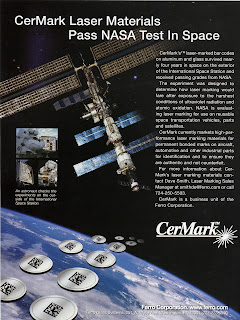Four Years In Space, Pass NASA’s Criteria
Part of Ferro Corporation’s Glass Systems business, CerMark Laser Marking materials have
 successfully survived nearly four years of Low Earth Orbit (LEO) exposure on the exterior of the International Space Station (ISS). CerMark supplied bar code test marks on aluminum and glass, which passed the National Aeronautics and Space Administration’s (NASA) criteria for its Material International Space Station Experiment (MISSE).
successfully survived nearly four years of Low Earth Orbit (LEO) exposure on the exterior of the International Space Station (ISS). CerMark supplied bar code test marks on aluminum and glass, which passed the National Aeronautics and Space Administration’s (NASA) criteria for its Material International Space Station Experiment (MISSE).“This is a significant achievement for CerMark’s laser marking business and Ferro Corporation as well,” said David Smith, Sales Manager, Laser Marking. “Our products have consistently produced high-quality, durable marks for years – and few products can claim space as a test market. We welcomed the opportunity and are extremely pleased with the results.”
Positioned on the lower portion of the ISS’s airlock chamber, Ferro’s marks were exposed to the experiment’s harshest conditions – receiving the maximum amount of ultraviolet (UV) radiation and atomic oxidation. Created by radiation from the sun, atomic oxygen is found in the upper atmosphere and is extremely corrosive. The oxygen on earth is a gas formed when two oxygen atoms make up a molecule.
Siemens Symbology Research Center (SRC), NASA’s lead contractor for the MISSE marking experiments, applied various test markings to the samples, including data matrix symbols, human readable characters and line patterns. SRC applied data matrix symbols to the aluminum and glass samples using Ferro’s LMM-6000, the company’s primary laser marking material, and Ferro’s RD-6005, respectively.
NASA used four criteria, including percentage of contrast, axial uniformity, print growth and error correction, for its post-flight evaluation of each mark.
MISSE is a multi-stage experiment designed to establish part identification methods and techniques that might survive the rigors of space. With the advent of reusable space transportation vehicles and satellites, NASA needed to rethink how part identification markings are applied – because marks applied to reusable spacecraft need to survive the extreme environments encountered in space.
However laboratories can simulate just one or two space environmental factors at a time. The only way to test how different materials will perform in space is to test them in that environment.
The research from MISSE will provide the insight needed to develop materials for future spacecraft and will also help researchers make materials and coatings that will last longer on earth.
MISSE 1 and 2, which included CerMark’s marks, intended to orbit for one year while MISSE 3 and 4 would orbit for three. However the recovery effort was delayed due to the tragedy with space shuttle Columbia in 2003.
MISSE 1 and 2 were launched with space shuttle Discovery (STS-105) on August 10, 2001, and astronaut Patrick Forrester positioned them on the outside of the ISS on August 16. Astronaut Stephen Robinson retrieved both on July 30, 2005 after 1,443 days of LEO exposure. MISSE 1 and 2 returned to earth when Discovery (STS-114) landed at Edwards Air Force Base on August 10, 2005.
During this mission, the new MISSE 5 was attached to the ISS for its stay in space as well.
CerMark Laser Marking business markets high-performance laser marking materials for permanent bonded marks on myriad aircraft, automotive and industrial parts and products. When compared to other identification procedures, laser marking provides several advantages including increased durability and speed, personalized or custom marks that can also be used for part identification and serialization, precise marks and localized heating.
CerMark’s laser marking materials can be brushed, sprayed or screen-printed onto a substrate using an airbrush or high-volume low-pressure spray gun. They can also be applied with laser marking tape, which utilizes the same materials. Regardless of application, the material and substrate bond only where the laser touches to create marks in a range of colors including red, black, blue, bronze and green. The excess laser marking material is removed to reveal the mark.
Ferro Glass Systems manufactures and markets an extensive variety of glass coating products for the automotive, architectural and container glass industries. It is the worldwide leader and supplier of ceramic and lead-free enamels and conductive paste for the automotive industry and lead-free enamels for architectural spandrels. It was the first firm to introduce lead-free enamels for spandrels and encouraged US glass manufacturers to switch to these environmentally preferred enamels. Glass Systems is leading the way for the adoption of organic, heavy-metal-free inks and coatings in the glass container industry. For more information, visit the company Web site at www.ferro.com.

No comments:
Post a Comment